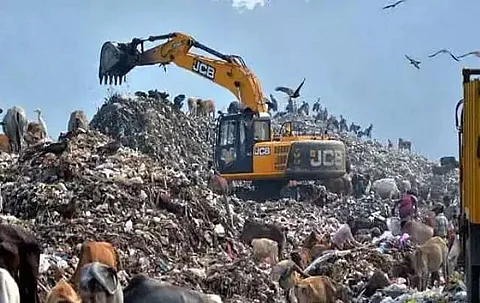
- Home
- Live Blog
- Breaking News
- Top Headlines
- Cities
- NE News
- Sentinel Media
- Sports
- Education
- Jobs

The second phase of the Swachh Bharat Mission (SBM)-Urban was launched in October last year to make all Indian cities 100% "garbage-free" but the growing heap of solid waste at the Boragaon dumping site in Guwahati demonstrates that the linear economy of 'take-make-waste' continues to pose a stumbling block to sustainable waste management in the capital city. The solution lies in a circular economy approach built on the 3R principle of 'reduce, reuse and recycle around which the SBM-U is anchored. The effectiveness of the circular economy approach in municipal solid and liquid waste can be gauged from the fact that urban India's solid waste treatment capacity has increased from 18% in 2014 when SBM-U was launched to the current level of 68%. Cities like Guwahati adopting the circular economy agenda in waste management is critical to achieving the objectives of the second phase of the flagship programme. Sector-specific and innovative approaches for sustainable management of municipal wastes segregated into dry waste, wet waste, construction and demolition waste and municipal sludge are required to address the key challenges. A thorough probe into the allegation of misappropriation of funds released to Guwahati Municipal Corporation for garbage disposal and desilting the city drains is a must to bring to the book all erring officials, employees and others involved in such corruption. A recent report brought out by the Ministry of Housing and Urban Affairs has brought to light that urban India currently generates 1.45 lakh solid waste every day 35% of which is dry waste and consists of different components such as plastic, paper, cardboard, glass, ceramic, metals, textiles, tyres and rubbers etc. Prohibition of Single Use Plastics (SUP) resulted in reduced use of plastics but banned SUP items continue to be in circulation due to poor enforcement and lack of awareness among the general public. Plastics account for about 46% of total dry wastes, and effective enforcement of the SUP ban will take away a significant percentage of plastics wastes. An estimated 24% of SUP in the country consists of packaging materials, replacing SUP packaging with recyclable packaging provides a sustainable solution. The report points out that policy and regulatory gaps such as the lack of incentives to encourage recycled products and the complex Extended Producer Responsibility framework under which producers are required to bear the responsibility for treatment or disposal of post-consumer goods, amongst others, have inhibited the potential of dry waste in the circular economy of the country. It harps on wastewater recycling and reuse as a reliable and long-term source of water supply to help non-potable water in the cities and recommends the creation of adequate sewage treatment capacity to meet the requirement of sewage generation in a time-bound manner and sets the targets for recycling and reuse of treated wastewater in the short, mid and long-term, at 25% by 2026, 35% by 2036 and 50% by 2050 respectively. It is estimated that India's urban population will grow to 600 million by 2030 and 814 million by 2050 and the generation of waste will increase to 165 million tonnes by 2030 and 436 million tonnes by 2050 which will become unmanageable if the cities fail to make the transition from a linear economy to the circular economy well in time. The report claims that dry waste recycling has the potential to generate revenue to the tune of Rs 11,836 crore per annum, and compost and Biofuel from wet waste can generate revenues of about Rs 365 crore and Rs 1,679 crore per annum respectively. It is estimated that resource recovery from construction and demolition wastes can generate about Rs 416 crore while treated sludge and wastewater can generate revenues of Rs 6,570 crore and Rs 3,285 crore respectively per annum. Cities adopting best practices like 100% waste segregation at source in Indore can help achieve the objectives of SBM-U in the current second phase provided such initiatives are scaled up and institutionalized and not limited to pilot projects of experimenting with new practices. The MoHUA report flagged the concern over the non-existence of a provision of waste management policies mandating a ban on disposal of recyclables in landfills leads to loss of valued resources in addition to creating environmental pollution. Two key challenges in wet waste management in cities identified in the report include poor segregation of waste at the source reducing the efficiency of the processing facility and inadequate infrastructure to transport segregated wet waste to processing facilities. Sewage generation in the country is estimated to increase to 94,773 million litres per day (MLD) by 2036 and 1.20 lakh MLD against the current installed treatment capacity of over 31,000 MLD presenting a challenging task for urban policy planners for establishing an institutional mechanism for circular economy in wastewater recycling and reuse. City authorities drawing a comprehensive roadmap for new waste management practices based on the circular economy approach is the need of the hour to achieve the objectives of SBM-U 2.0.